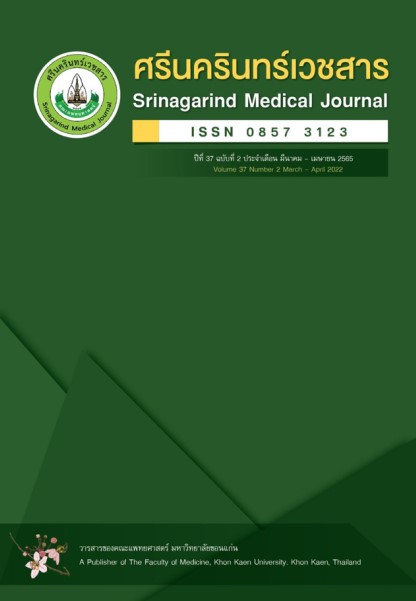ทัศนคติและการรับรู้ของผู้บริจาคโลหิตในอนาคตระหว่างช่วงการระบาดของ Covid-19
Abstract
Attitudes and Perceptions of Future Blood Donors During Covid-19 Pandemic
หลักการและวัตถุประสงค์: เพื่อสำรวจความตระหนัก เจตคติ และการรับรู้เกี่ยวกับภาวะวิกฤติการขาดแคลนเลือดในช่วงการระบาดของ COVID-19
วิธีการศึกษา: เป็นการศึกษาเชิงพรรณนาแบบตัดขวางได้ดำเนินการศึกษาในนักเรียนไทยระดับมัธยมศึกษา เข้าร่วมการศึกษาโดยการตอบแบบสอบถามผ่านแอปพลิเคชันออนไลน์ (online application) ที่ประเมินแรงจูงใจที่เกี่ยวข้องกับความตั้งใจในการบริจาคโลหิต และแบบสอบถามยังรวมคำถามที่เกี่ยวข้องกับเครื่องมือที่ใช้ในการสื่อสารที่เกี่ยวกับกระบวนการบริจาคโลหิต ค่าทางสถิติพรรณนาใช้การคำนวณความถี่ ร้อยละและค่าเบี่ยงเบนมาตรฐาน
ผลการศึกษา: กลุ่มตัวอย่างที่เข้าร่วมการศึกษาทั้งหมดเป็นนักเรียนไทยในชั้นมัธยม จำนวน 620 ราย คิดเป็นอัตราส่วนชายต่อหญิงเท่ากับ 1:1.63 จากจำนวนของประชากรที่ศึกษาพบว่า มากกว่าร้อยละ 70 มีความตระหนักในภาวะวิกฤติขาดแคลนเลือดในช่วงการระบาดของ COVID-19แต่มีเพียงร้อยละ 26.84 ของเพศหญิงและร้อยละ 16.67 ของเพศชายที่แสดงความตั้งใจที่จะบริจาคโลหิต ช่องทางที่ได้รับความนิยมมากที่สุดในการติดต่อสื่อสารสำหรับรับข้อมูลข่าวสารในผู้เข้าร่วม คือ สื่อโซเชียลมีเดีย (social media platform) ซึ่งพบในเพศหญิง ร้อยละ 46.32 และพบในเพศชายร้อยละ 39.17
สรุป: นักเรียนชั้นมัธยมซึ่งเป็นผู้สามารถบริจาคเลือดในอนาคตควรได้รับการเอาใจใส่เพื่อปลูกฝังค่านิยมที่ดีของการบริจาคโลหิต โดยเฉพาะอย่างยิ่งนักเรียนเพศชายที่มีความสนใจในการบริจาคโลหิตค่อนข้างต่ำ ควรให้ความรู้และกระตุ้นให้กลุ่มนี้สนใจที่จะมาบริจาคเพิ่มขึ้น วิธีหลักที่ใช้ในการสื่อสารควรผ่านทางโซเชียลมีเดีย ในขณะที่การสื่อสารในโรงเรียนสามารถใช้เป็นสื่อเสริมได้
Background and Objectives: The aim of this study was to investigate the awareness, attitudes and perceptions on the crisis of blood scarcity during the Covid-19 pandemic.
Methods: A cross-sectional descriptive study was conducted in the secondary school Thai students. They participated the study by responding the questionnaires via on-line application that assessed the motivation for the intention in blood donation. In addition, the questionnaires also included other questions relating to types of public communication regarding to the process of blood donation. Descriptive statistics of frequencies, percentages, and standard deviation were calculated and presented.
Results: A total of 620 secondary school Thai students were included in this study with male to female ratio of 1:1.63. More than 70% of all participants had realized that there is crisis of blood shortage during Covid-19 pandemic; however, only 26.84% of female and 16.67% of male had an intention to donate blood. The most favorable channel for communication to receive news and information in participants was social media platform. This was found in 46.32% of female and 39.17% of male.
Conclusions: The secondary school students who are eligible blood donors in the future should be essentially concerned to be educated correctly in blood donation. Importantly, Thai male students, who had low intention of donating blood, should be intensively focused and encourage them to voluntarily donate blood. Additionally, the main method used for communication in Thai students should be social media platform while public communication presented in school can be a supplementary channel.
Keywords: blood donation, Covid-19 pandemic, attitudes, blood shortage


